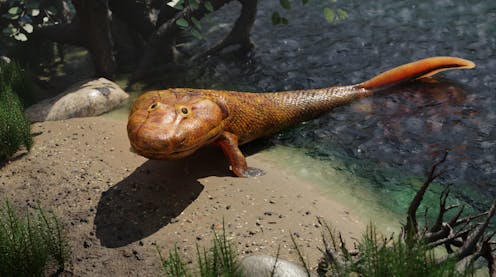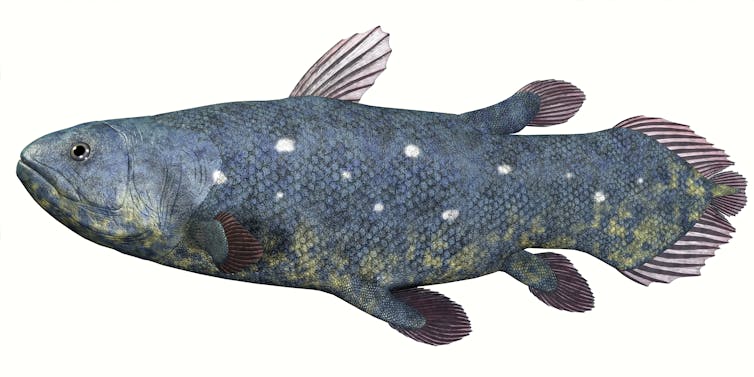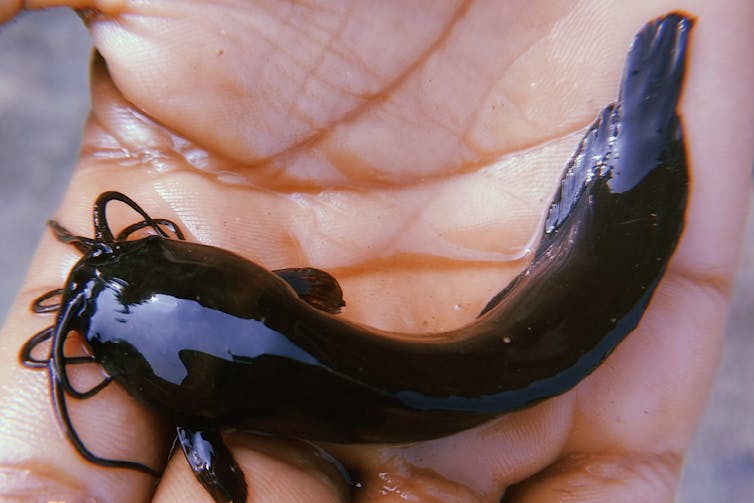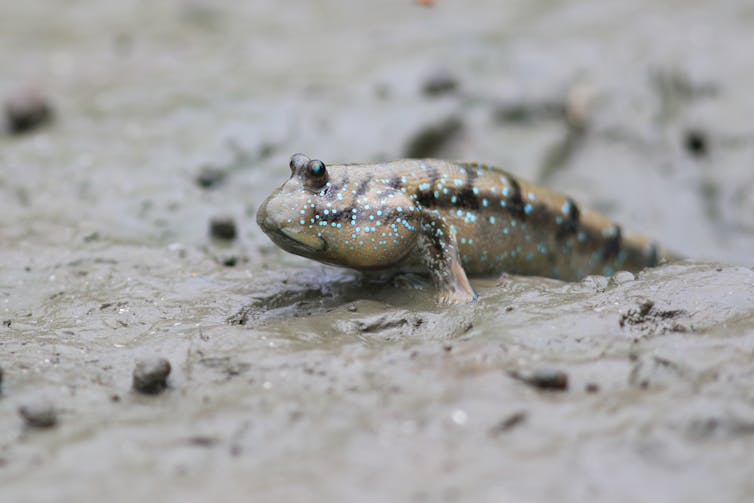
When you think about human evolution, there’s a good chance you’re imagining chimpanzees exploring ancient forests or early humans daubing woolly mammoths on to cave walls. But we humans, along with bears, lizards, hummingbirds and Tyrannosaurus rex, are actually lobe-finned fish.
It might sound bizarre but the evidence is in our genes, anatomy and in fossils. We belong to a group of animals called land-dwelling sarcopterygians, but vast amounts of evolutionary change have obscured our appearance.
We think of fish as expert swimmers, but in fact they have evolved the ability to “walk” at least five times. Some species pull themselves forward using well developed fore-fins, while others “walk” along the ocean floor.
Our sarcopterygian ancestor evolved lungs and other air-breathing mechanisms, bony limbs, and a stronger spinal column before venturing on to land. These adaptations were useful not only in aquatic environments but allowed our ancestors to explore land – they were “pre-adaptations” for life on land.
The water-to-land transition was one of the most significant events in vertebrate evolution. It may have started as a way to escape from predators, but the landscape our ancestors discovered was already rich with plants such as mosses, horsetails and ferns, as well as arthropods (millipedes) which had colonised land millions of years earlier.
We are not alone
Walking independently evolved several times in fish, making it an example of evolutionary convergence (similar traits that evolve independently, like wings in bats and birds). The evolution of walking in fish is rare though. There are more than 30,000 species of fish as we know them today (not in the evolutionary sense), of which only a handful can “walk”.
Sarcopterygians differ from other types of fish in several important ways. For example, our fins (limbs) have bony supports and muscular lobes that allow us to move on land.
This adaptation is thought to have been crucial for tetrapod (amphibians, mammals, reptiles and birds) evolution during our transition from water to land in the Late Devonian period, some 375 million years ago. Many of the genes involved in forming limbs and digits in tetrapods are also found in water-bound sarcopterygians like lungfish, which indicates these traits evolved in our ancient common ancestor.

We don’t know which species this ancestor was, but it probably looked similar to the coelacanth, which has a rich fossil record and is a “living fossil” that today inhabits the West Indian Ocean and Indonesia.
Walking sarcopterygian fish are either extinct, like Tiktaalik, or so highly evolved that we don’t recognise them as fish any longer (tetrapods).
One example of a living fish that walks is the mudskipper (of the Oxudercidae family). These fish live in mangrove swamps and tidal flats and use their pectoral fins to walk on land. These fins help them to escape from aquatic predators, forage for food (they consume organic material in mud), and even interact with each other on land by finding mates.
Another example is the walking catfish (Clarias batrachus), which uses its pectoral fins to travel over land, helping it escape from drying ponds and find new habitats.

How did genes related to walking first evolve?
The little skate (Leucoraja erinacea) is a cartilaginous fish related to rays and sharks (as opposed to bony fish, including sarcopterygians). It is another fish that “walks” underwater on fins like legs, mimicking the movements of land-based animals.
The little skate is of great interest to scientists researching the evolution of locomotion because it evolved fin-based walking independently from sarcopterygians. However, until now, the genetics behind the walking of the little skate was difficult to study due to a lack of quality data.
That changed recently when researchers from Seoul and New York used cutting-edge technology to construct a high-quality assembly of the little skate’s genome. The scientists discovered that it only uses ten muscles for fin-based walking, while tetrapods commonly use 50 muscles to move their limbs.
A big question about vertebrate evolution is: what genes are important for developing the muscles that enable walking? To find out, the team looked at which genes were active in the nerves that control limb muscles (motor nerves) in a mouse, chicken and little skate.
They discovered similar gene expression patterns in motor nerves that help these muscles function. So walking fish may have taken several different evolutionary paths, but this recent study suggests a common genetic mechanism.

Humans evolved to be the best walkers
By the end of the Triassic period roughly 201 million years ago, both dinosaurs and mammals had evolved excellent running abilities. Humans refined these locomotor powers, evolving numerous adaptations that make us one of the most efficient and capable running species on the planet.
These adaptations include a spring-like Achilles tendon which helps store energy, a long stride and balanced centre of gravity, and sweating to cool down. These adaptations allow us to run long distances with great endurance, though at slow speeds.
Our ancestors used running for hunting, to escape predators, and for foraging. It has shaped our anatomy, physiology and culture. And many studies show that walking and running are crucial to our wellbeing and physical health.
It has been a long road from the origin of walking in our fish-like ancestors who first colonised land. But walking and running remain a central part of our lives, and our evolutionary success.
Chris Organ does not work for, consult, own shares in or receive funding from any company or organisation that would benefit from this article, and has disclosed no relevant affiliations beyond their academic appointment.
This article was originally published on The Conversation. Read the original article.







